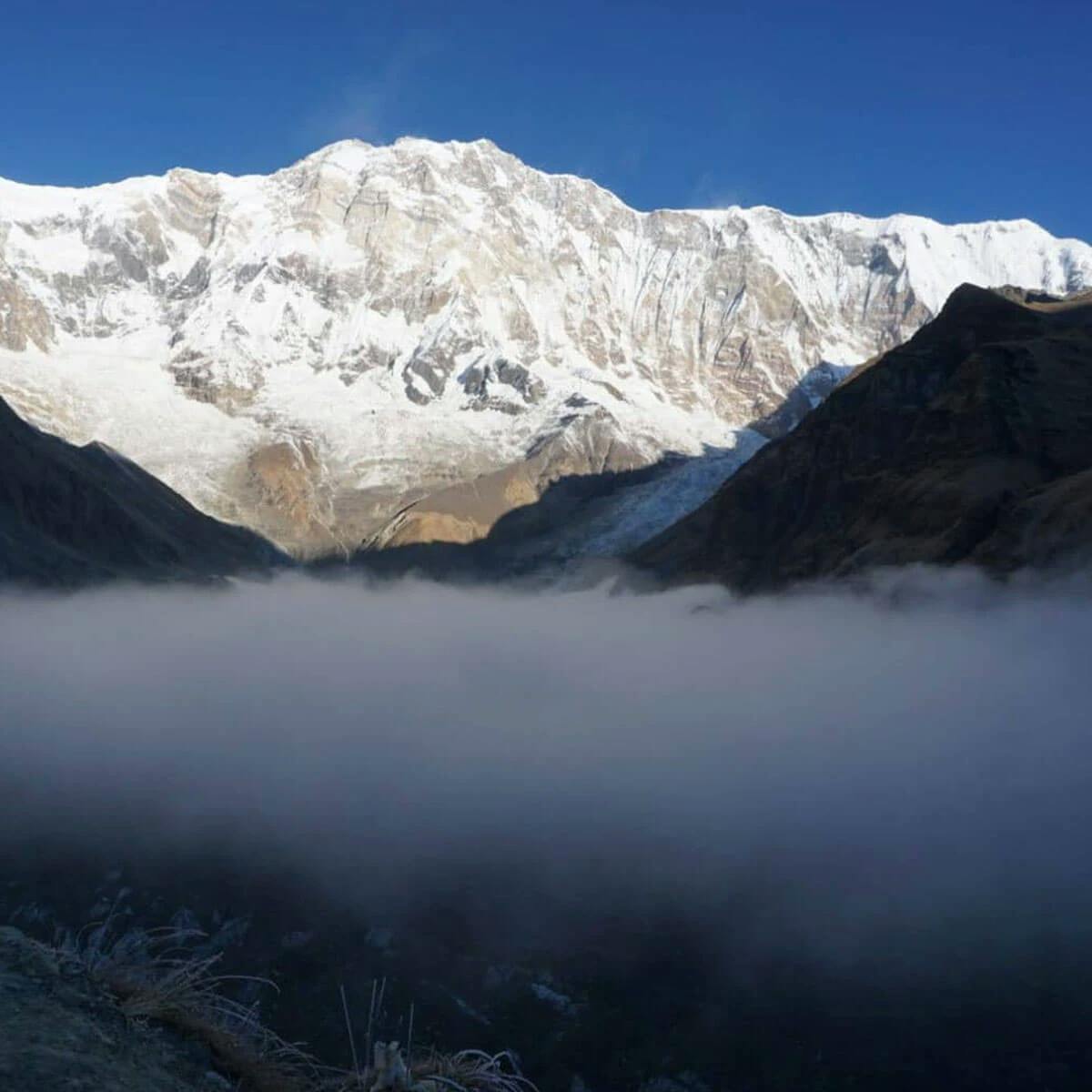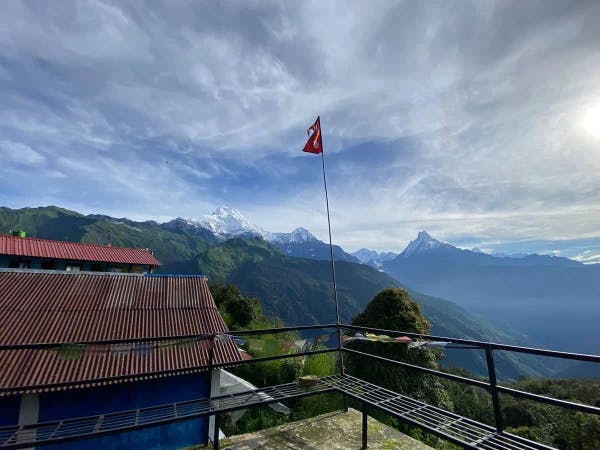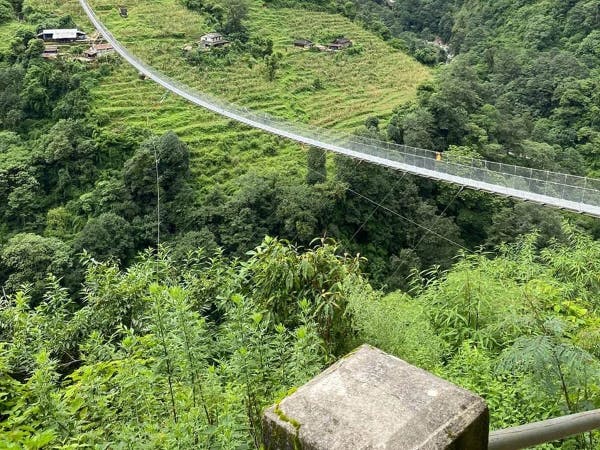Ammonite Adventures is outstanding! Booking a trek was extremely customizable and catered perfectly to my stay in Nepal. I fell
Otherwise known as the Annapurna Sanctuary Trek, the journey to the Annapurna Base Camp is an adventurous walk through not only naturally rich but also culturally rich land inside the Annapurna Conservation Area.
The trekking trail of Annapurna Base Camp follows the winding roads along the bank of the Trishuli River in the first half, and later on, the Marshyangdi enters the surpassing beauty of flora and fauna, passing by dense woods of oak, rhododendrons, and bamboo in the lower region and alpine vegetation in the upper Himalayas.
Therefore, the Annapurna Base Camp expedition is an opportunity that provides you with everything from the sky-towering peak, lush forests, and enriching culture to be called the true Himalayan classic tea house voyage, suitable for everyone from beginners to professional climbers.
Throughout this beautiful trek to the Annapurna Base Camp, you will notice the stunning landscapes, varied climatic zones, and lovely dwellings of locals, along with the otherworldly vistas of numerous peaks, which look more refined and extensive from different vantage points of Poonhill, and the Base Camp of Annapurna itself.
Highlights
- Enjoy a scenic drive through the countryside valleys between the capital city of Nepal, Kathmandu, and another tourist paradise, Pokhara.
- View the magnificent backdrop of Annapurna and Dhaulagiri, including Machapuchare, in the crystal-clear water of Phewa Lake.
- Savor a jaw-dropping sun setting over panoramic mountain peaks from Ghorepani and Poonhill.
- Venture deep into the culturally fascinating and charming traditional mountain villages of the Annapurna region.
- Treat yourself to a relaxing hot spring bath at Jhinu Danda.
- Appreciate the warm hospitality of the Himalayan tribal people of Gurung and Magar.
- Panoramic views of Annapurna, Dhaulagiri, Machapuchare, Gangapurna, Khangsar, Hiunchuli, and many more.
- Get close to the tenth highest peak in the world, Mt. Annapurna (8,091m), etc.
What to expect during the journey to the Annapurna Base Camp?
The 10-day journey to the base camp of Mt. Annapurna begins with a quick drive to Nayapul, from where the trek officially commences through the settlements of locals dotted with vibrant prayer flags, chhortens, ancient monasteries, and stupas, adding much to the divinity of the landscapes and bestowing blessings upon you for a prosperous voyage.
As you ascend higher, the amazing scenery will excite you even more as you pass by the villages showcasing the mixed culture of the ethnic communities of Thakalis, Magars, and Gurungs following Buddhism and Hinduism. These Himalayan lifestyles of the locals are truly inspiring because they have preserved their unique costumes and culture left behind by their forefathers.
The brightly gleaming snow-clad peaks in the pristine blue sky with scattered cotton-like clouds fascinate each trekking aspirant, which seems unbelievable at first sight. Where you can expect:
Never-ending panoramic sights of mountains
The Annapurna trekking region where the Annapurna Base Camp expedition takes place is dominated by the majestic peak of the tenth tallest mountain in the globe, Mt. Annapurna (8,091 m), that you can see even before you begin to head for the trekking trail from Pokhara.
Furthermore, our 10-day venture to the Annapurna Base Camp provides you with wonderful, never-before-seen views of other snow-covered mountains such as Mt. Dhaulagiri, Mt. Machapuchare (6,993m), Mt. Nilgiri (7,061m), Mt. Gangapurna (7,455m), Mt. Hiunchuli (6,441m), and Tukuche Peak (6,920 m), including Annapurna I (98,091m), Annapurna II (7,219m), Annapurna III (7,555m), Annapurna IV (7,525m), and Annapurna South (7,219m).
Astonishing Sunrise and Sunset views from Poonhill
Located in the Annapurna region of Nepal, Poonhill, at an altitude of 3,210 m above sea level, is a famous lofty hill serving as one of the best viewpoints to relish the 360-degree view of the surrounding heavenly mountains.
Watching the sunrise and sunset from here is a widely preferred activity amongst trekkers and travelers, as the Poonhill opens a unique perspective of the entire Annapurna region, including the complete view of the Annapurna ranges and Dhaulagiri.
Due to its easier access than the Annapurna Base Camp, the Ghorepani Poonhill Trek is on the bucket list of many adventurers who desire to see the more extensive and exclusive scenic sight of the whole Annapurna and its peaks, along with several other unnamed ranges.
Some of the renowned mountains seen from the Poonhill are the scenically phenomenal Annapurna I, Annapurna South, Machapuchare, and Dhaulagiri captured as the background of the photograph.
Admirable traditional life in Ghorepani
One of the noteworthy Gurung and Magar villages of the Annapurna Conservation Area, Ghoreapani, is established at an elevation of 2,874 m, which provides a comprehensive insight into the daily customs of the remote areas of Nepal.
The locals from here have preserved and given continuation to their distinctive way of life. They possess their own traditional dances, rituals, attires, festivals, and dialects that visitors would not be able to help to fall in love with while enjoying the welcoming nature and hospitality of the people from Ghorepani.
It would be holistic to watch the villagers engage themselves in agriculture while roaming around the tightly packed alleyways in between typically styled houses made up of stone and wood. Crafting and pottery are also part of their everyday lives, along with paying respect and visiting shrines.
To conclude, Ghorepani is not just a hub for trekkers and travelers but also a spiritually fulfilling destination as you move along the Buddhist stupas and Mani walls festooned with colorful prayer flags.
Soak yourself in the natural hot spring of Jhinu Danda
Jhinu Danda, at an elevation of 1,780 m (5,840 ft), is a tiny settlement on a ridge of the Annapurna trekking region overlooking the Modi Khola River, which is a haven for Annapurna Circuit and Annapurna Base Camp trekkers to take a break and unwind.
The communal and private natural hot spring of Jhinu Danda is famous for taking a rejuvenating bath, offering a welcome respite for sore muscles after days of journey to the Annapurna Base Camp, as they are naturally soothing and have healing qualities.
If you are seeking a more private and intimate experience, the private hot spring of the teahouses is just made for you in a natural setting surrounded by lush greenery, with the overlook at the below-flowing river surrounding hills and mountains providing a better tranquil ambiance for relaxation. Nothing beats up Jhinu Danda and its hot spring to cap off the trek to the Annapurna Base Camp.
The top-notch serenity of the Annapurna Conservation Area
Along the 10-day adventure to Annapurna Base Camp, you will be walking through one of the highly protected realms of Nepal to preserve the region's original culture, tradition, fragile Himalayan ecosystem, and natural diversity, called Annapurna Conservation Area.
Since the area is home to a vast array of flora and fauna and belongs to conserved land, it assures you of the raw wilderness untouched and untainted by any modernity en route to the Annapurna Base Camp pilgrimage.
The dense forest of oak, pine, and rhododendrons, with bamboo dotted in between, is picturesque and one of the unique features that is visually appealing and pleasing to walk through. In spring, the whole region blooms fully in various colors, enhancing the scenery ten times more than ever.
Furthermore, the Annapurna Conservation Area, covering 7,629 square kilometers, is inhabited by 518 species of avians and 348 species of butterflies, forming a natural melody of the Himalayas that can be heard throughout the region en route to the Annapurna Base Camp.
Annapurna Base Camp Itinerary
The Annapurna Base Camp 10-day trip starts from the moment you have landed in the capital city of Nepal, Kathmandu. The essential permits would have been ready while you were driven to Pokhara and transported to the hotel for the day.
The very next day, you will be boarding a local bus up to Nayapool, from where the hike traditionally begins, and taking a day break at Ulleri. From Ulleri, this 10-day itinerary for the Annapurna Base Camp expedition stops at Ghorepani and eventually at Tadapani to climb the Poonhill for an extraordinary sunrise above the nearby mountains.
After spending a joyous four nights at Tadapani, Chomrong, Bamboo, and Deurali, you will visit the major highlight of the overall Annapurna region, Annapurna Base Camp, to witness the surreal dawn from 4,130m above sea level, which is definitely a dream of each adventurer who believes in “chasing angles or fleeing demons, go to the mountains” by Jeffrey Rasley.
The following morning, after waking up to the ethereal beauty of the Annapurna ranges, you will head back to Bamboo. From Bamboo, Jhinu Danda is traced to let your muscles loosen up a bit in the natural hot spring, which has been found to have a health benefit that can effectively cure any sort of skin ailments.
Then, the next day calls the drive to the tourist hub of Pokhara before a final day ride to Kathmandu on the 10th day. This itinerary from Ammonite Adventure & Treks Pvt. Ltd. is amazingly flexible you can be customized according to your needs and preferences and we can assist you efficiently.
We suggest you add a few extra days, which may be 2-3 days, rather than cutting out the Annapurna Base Camp Trek days from the 10-day itinerary to acclimate well to the weather and climatic conditions of the country of hills and mountains, Nepal.
Annapurna Base Camp 10 Days Trek Cost
The package cost to go on the Annapurna Base Camp Tour for 10 days can range from USD 850 to USD 1,500 or more depending upon the size of your trekking group, route, and time, along with the duration, as the 10-day itinerary to go on the Annapurna Base Camp voyage is customizable as per your needs and preferences.
The minimum number of trekkers to go the Annapurna Base Camp Trek is 2 since the banning of free individual trekkers in Nepal on April 1, 2023, and it can be costlier than doing it with a larger group while sharing the expense and tales of the adventure. These are just the estimated package costs. Ammonite Adventure & Treks Pvt. Ltd. is offering a special discounted price on 10 days of Annapurna Base Camp trekking with a group of more than 10 members.
This package undoubtedly pays for required permits, transportation used during the trek, food, accommodation, guides, and porters, along with their everyday salaries, travel insurance, and essentials. On your request, we can arrange you more upgraded services on meals and rooms, but you must understand that it will cost you a little more than the usual Annapurna Base Camp package, along with additional stays if you extend the itinerary.








